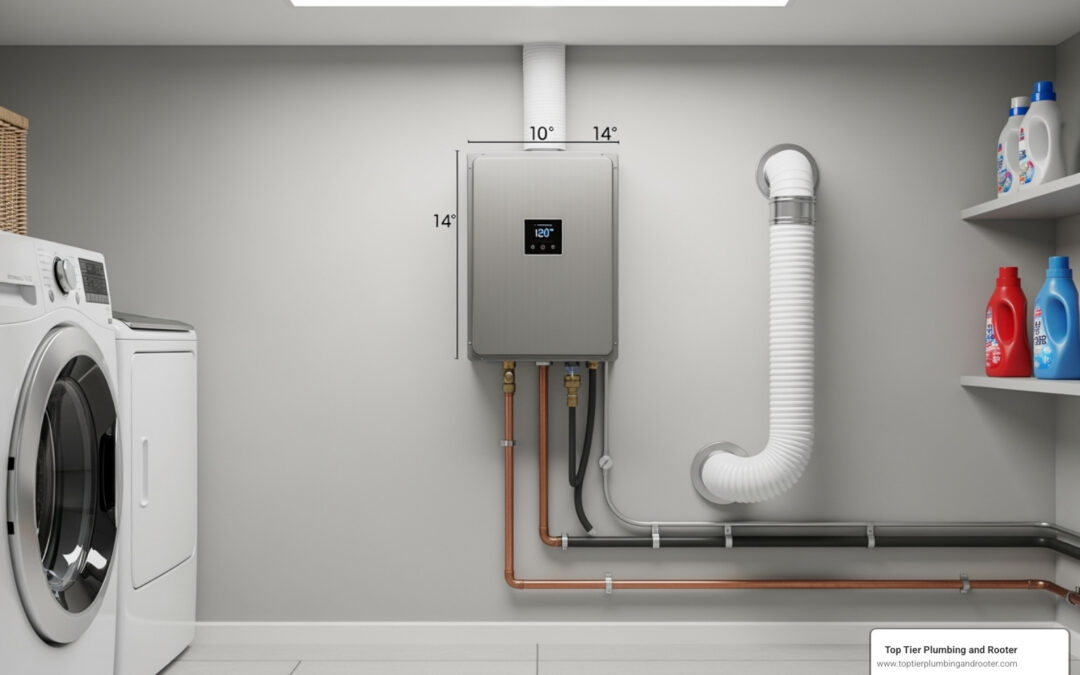Why Your Tankless Water Heater Needs Troubleshooting
Tankless water heater troubleshooting is essential when your endless hot water supply fails. While these modern, energy-efficient units are reliable, they can develop problems that leave you in the cold.
Quick Troubleshooting Checklist:
- Check power supply – Circuit breaker, gas valve, or electrical connections
- Verify water flow – Main water valve open, inlet filter clean
- Review error codes – Display panel messages indicate specific issues
- Test ignition system – Gas pressure, flame sensor, air intake clear
- Assess water quality – Mineral buildup, temperature fluctuations, low pressure
Most issues fall into predictable categories: no hot water (power/gas supply), fluctuating temperatures (flow rate/mineral buildup), strange noises (sediment/loose parts), and low water pressure (clogged filters).
Many problems have simple DIY solutions, like resetting a breaker or cleaning a filter. However, issues like gas leaks, major electrical faults, or persistent error codes require a professional.
Understanding your unit helps prevent future issues. Tankless heaters need a minimum water flow (0.4-0.6 GPM), proper venting, adequate gas pressure, and regular maintenance to work reliably.
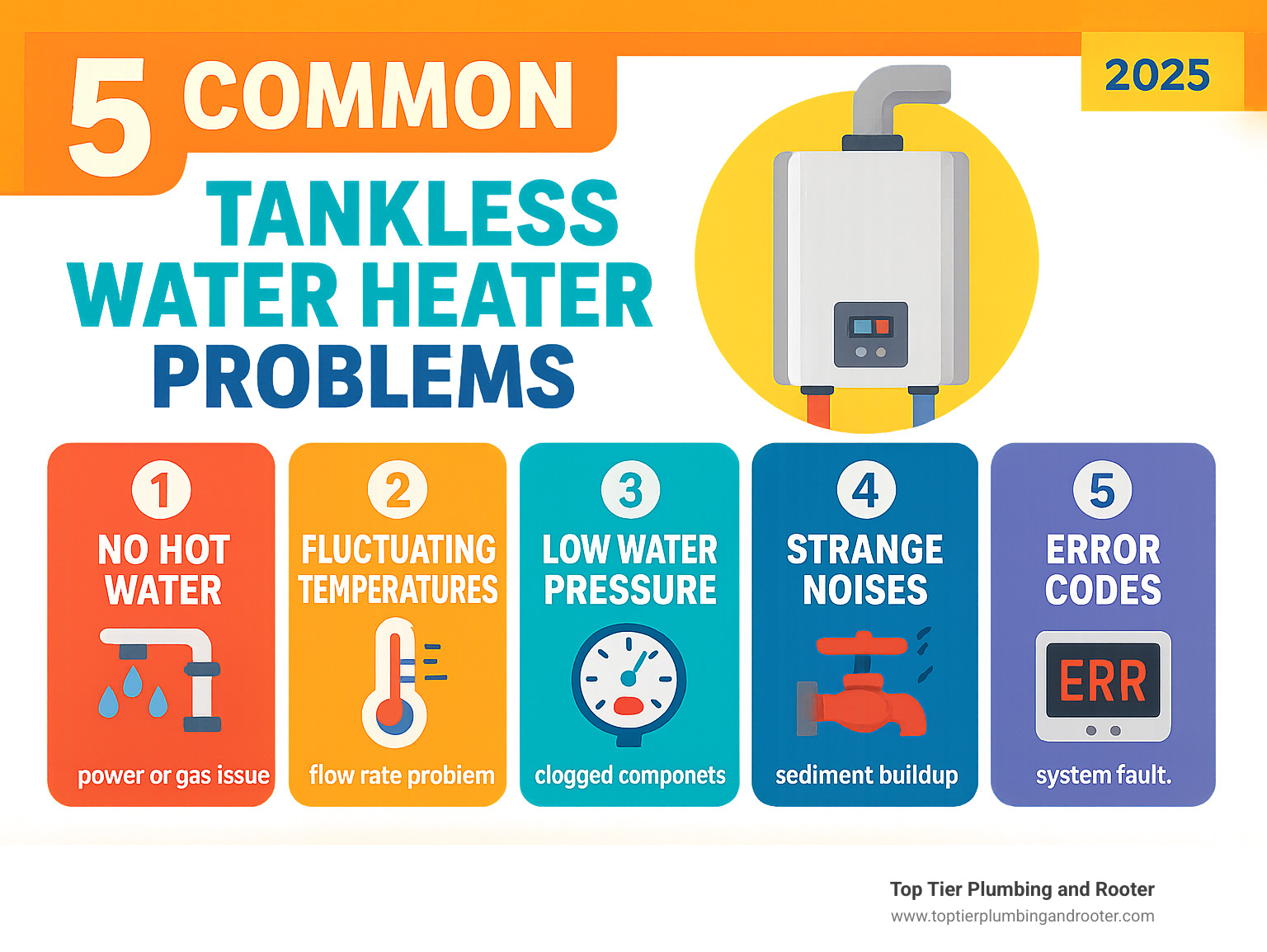
First Checks: Power, Water, and Basic Resets
When your tankless water heater stops working, start your tankless water heater troubleshooting with the basics. Often, the simplest solutions are the right ones.
Your unit needs power, water flow, and a functioning control system to operate. A failure in any of these can leave you with cold water.

No Power or Unit Won’t Turn On
If the unit won’t turn on, power issues are the likely culprit. For electric models, check your circuit breaker panel for a tripped breaker or blown fuse.
Ensure the unit’s power switch is on, the outlet connection is secure, and check for any loose wiring, which can even occur in new units.
For gas units, confirm the gas supply valve is fully open. If you use propane, check the propane tank level.
Important safety note: If you smell gas anywhere near your unit, turn off the gas supply immediately and call a professional. Gas leaks aren’t DIY territory.
Checking Water Supply and Error Codes
After checking power, verify the water supply. Ensure the main water valve is fully open. Check the inlet filter screen for clogs, as this can restrict water flow and prevent the unit from activating.
Modern units display error codes to identify problems. Consult your manufacturer’s manual or online resources like the Help Desk to understand these codes.
A simple reset can often fix temporary glitches. Turn the unit’s power off for a minute, then turn it back on.
If these basic checks don’t work, you’ll need to investigate further. However, these first steps solve a surprising number of tankless water heater troubleshooting calls.
Expert Tankless Water Heater Troubleshooting for Ignition and Heating
If basic checks fail, advanced tankless water heater troubleshooting may reveal issues with ignition, gas supply, electrical components, or sensors. These parts must work together, and a single failure can disrupt the entire system.
To troubleshoot effectively, understand that your heater needs a precise mix of gas pressure, airflow, and electrical signals to ignite. An imbalance in these elements will cause heating problems.
‘No Ignition’ or ‘Flame Failure’ Errors
When you see “no ignition” or “flame failure,” your unit is failing to light.
Gas pressure issues are a common cause. An undersized gas line can’t provide enough fuel for the unit to maintain a flame, leading to intermittent ignition problems, especially during peak use.
Also, verify that your main gas supply and the unit’s individual gas valve are fully open.
A dirty igniter or faulty flame sensor can prevent ignition. Debris can coat these components, weakening the spark or preventing the sensor from detecting a flame, which triggers a safety shutdown.
Blocked air intake or exhaust vent obstruction are safety hazards. Debris can obstruct these pathways, and the unit’s safety systems will prevent ignition if a blockage is detected.
For comprehensive solutions to these complex ignition issues, our team provides expert tankless water heater services throughout Riverside and San Bernardino counties.
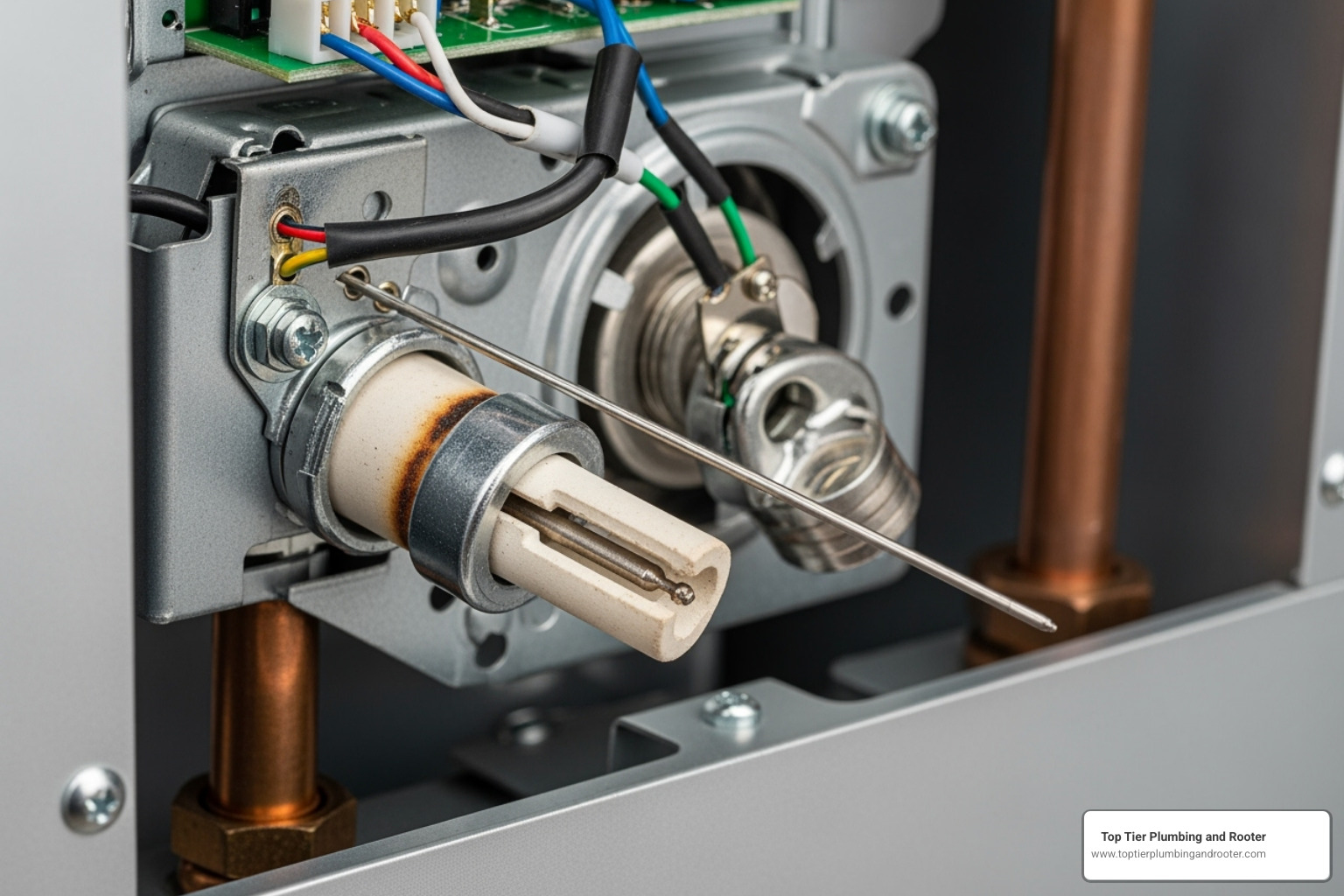
Water Isn’t Getting Hot Enough
When your water isn’t hot enough, several factors could be at play.
First, check the temperature setting, which is often accidentally changed. It should be around 120°F. A thermostat malfunction can also misread temperatures, resulting in lukewarm water.
An undersized unit may not meet your household’s demand. It might handle one shower but struggle with simultaneous uses. This is a capacity limitation, not a malfunction.
An undersized gas line can also limit heating potential, preventing the unit from reaching full power.
The cold water sandwich effect, a brief flow of cold water between hot water cycles, is another common issue.
A plumbing crossover issue, where cold water mixes into the hot water line, can also cause heating problems. To check for this:
- Shut off the cold water supply valve to your tankless water heater
- Open a hot water faucet and let it run until the flow stops
- Check for continued water flow – if water keeps flowing, cold water is entering your hot water line somewhere
- Contact a professional if you find this crossover, as pinpointing the location requires expertise.
Solving Water Quality and Flow Problems
When a tankless water heater acts up, the cause is often poor water quality or flow issues, which can make the unit unreliable.
Mineral Buildup, Discolored Water, and Bad Odors
In areas with hard water, like Riverside and San Bernardino counties, mineral buildup is a major problem. Calcium and magnesium crystallize on the heat exchanger, forming an insulating layer of scale that forces the unit to work harder to produce lukewarm water.
Signs of hard water damage include reduced hot water flow, hissing or popping sounds from the unit, and discolored water.
A sulfuric “rotten egg” odor often indicates bacterial growth in sediment buildup. Tankless units lack anode rods and rely on regular cleaning to prevent this.
The solution is regular flushing and descaling. In hard water areas, this should be done every six months; annually is sufficient for softer water. This tankless water heater troubleshooting task involves circulating a descaling solution, like white vinegar, through the unit to dissolve mineral deposits.
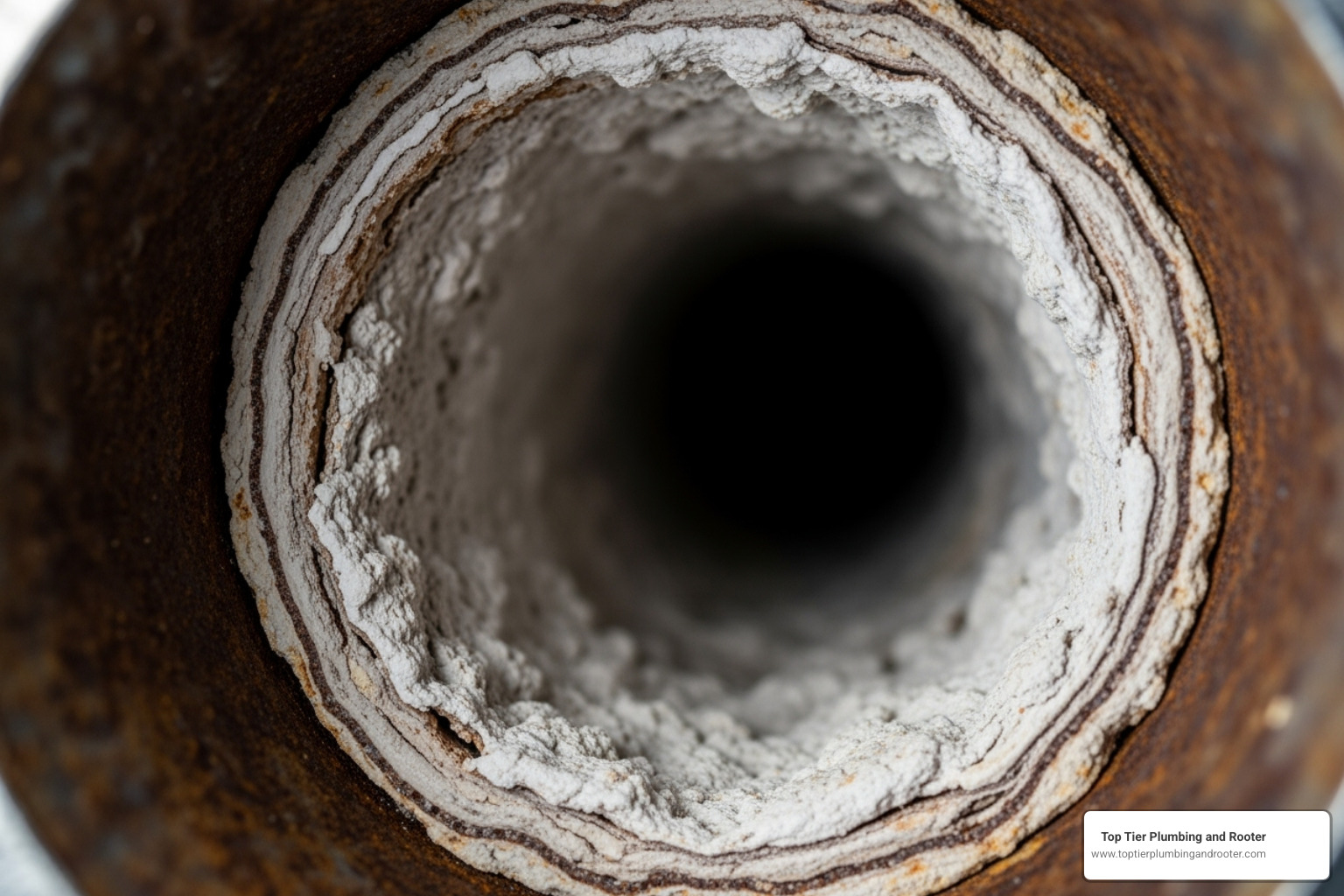
Follow proper procedures to avoid damage. You can Watch our Water Heater Flushing Procedure video on YouTube for guidance. Regular maintenance prevents expensive repairs, as detailed in our guide on Maintaining Your Tankless Water Heater: Tips for Longevity and Efficiency.
DIY Tankless Water Heater Troubleshooting for Low Pressure
Low water pressure is a critical issue for tankless units. They require a minimum pressure and flow rate (0.4 to 0.6 GPM) to operate. If the flow drops too low, the unit will shut down.
Start by checking for a clogged faucet aerator or blocked showerhead. If low pressure is isolated to one fixture, cleaning it will likely solve the problem.
Next, check the unit’s inlet water filter. A clogged filter restricts flow. To clean it, turn off the water supply, remove the filter, rinse it, and reinstall it.
If low pressure affects your entire house, the issue could be the main water pressure regulator. Adjusting this device requires a professional to avoid damaging your plumbing.
TABLE: Causes of Low Pressure and Solutions
| Cause | Common Signs | DIY Solution | When to Call a Pro |
|---|---|---|---|
| Clogged Faucet Aerator/Showerhead | Low flow at specific fixture, good flow elsewhere. | Unscrew, clean, and reattach aerator/showerhead. | If cleaning doesn’t help or multiple fixtures are affected. |
| Clogged Unit Inlet Filter | Reduced overall hot water flow from tankless unit. | Turn off cold water supply, remove filter, rinse clean, reattach. | If filter is damaged or unit still has low flow after cleaning. |
| Low Main Water Pressure | Low pressure throughout the house, both hot and cold. | Check main water shut-off valve is fully open. | If main valve is open and pressure remains low (could be municipal issue or pressure regulator malfunction). |
| Water Pressure Regulator Malfunction | Inconsistent pressure, sudden drops, or constantly low pressure. | (Limited DIY) Ensure main valve is open. | Immediately if suspected; requires professional adjustment or replacement. |
Fluctuating Temperatures and System Overload
Fluctuating temperatures are a common complaint in tankless water heater troubleshooting.
The “cold water sandwich” effect is one cause, which is a normal part of operation. More serious causes include faulty temperature sensors or blocked internal filters, which create inconsistent heating.
System overload occurs when demand exceeds the unit’s capacity (GPM). Running multiple hot water appliances at once can overwhelm the heater, causing temperature fluctuations or a shutdown.
An undersized unit will constantly struggle with capacity issues as your family’s needs grow. If you frequently face these problems, consider an upgrade. Our guide on The Advantages of Upgrading to a Tankless Water Heater can help you decide if this is the right choice.
Decoding Strange Noises and Stopping Leaks
Strange noises or leaks from your tankless water heater require tankless water heater troubleshooting. While alarming, these signs are clues to the problem, and many have straightforward solutions.
Why Is My Tankless Water Heater So Noisy?
Your tankless water heater should operate quietly. Loud noises are valuable clues about internal problems.
Rumbling and popping sounds usually indicate sediment buildup on the heat exchanger. Mineral deposits trap water, which then superheats and creates steam bubbles that pop.
Clicking noises are normal during startup, but continuous clicking without ignition suggests a failing igniter.
A whining or high-pitched sound often points to a problem with the fan motor, possibly caused by debris or worn bearings.
Banging or rattling typically means a component has come loose. Tightening accessible mounting brackets and connections can often resolve this.
Water hammer is a banging sound that occurs when taps are shut off quickly, causing pressure waves in the pipes.
For most noise issues, flushing the system to remove sediment and tightening loose connections are the first steps. Regular maintenance is the best prevention.
What to Do if Your Tankless Water Heater is Leaking
Finding a leak around your tankless unit requires a calm, methodical approach.
Your first priority is safety. Shut off the cold water supply valve to the unit. For electric models, turn off the circuit breaker. For gas models, turn off the gas supply valve.
Once the area is safe, identify the leak’s source. Loose connections are a common cause due to thermal expansion and can often be fixed by gentle tightening.
Worn seals and gaskets also cause leaks. These components degrade over time, so check around valve connections for signs of wear.
Check the pressure relief valve. Minor discharge can be normal, but constant dripping indicates either excessive system pressure or a faulty valve that needs replacement.
Distinguish between condensation and a true leak. Condensation can form on pipes in humid conditions. Wipe the area dry; if moisture reappears from a specific point, it’s a leak.
Internal corrosion is the most serious cause of leaks. It can occur if water quality issues are ignored and usually requires professional repair or replacement.
For comprehensive guidance on any type of water heater leak, our Water Heater Leak: Complete Guide walks you through every scenario you might encounter.
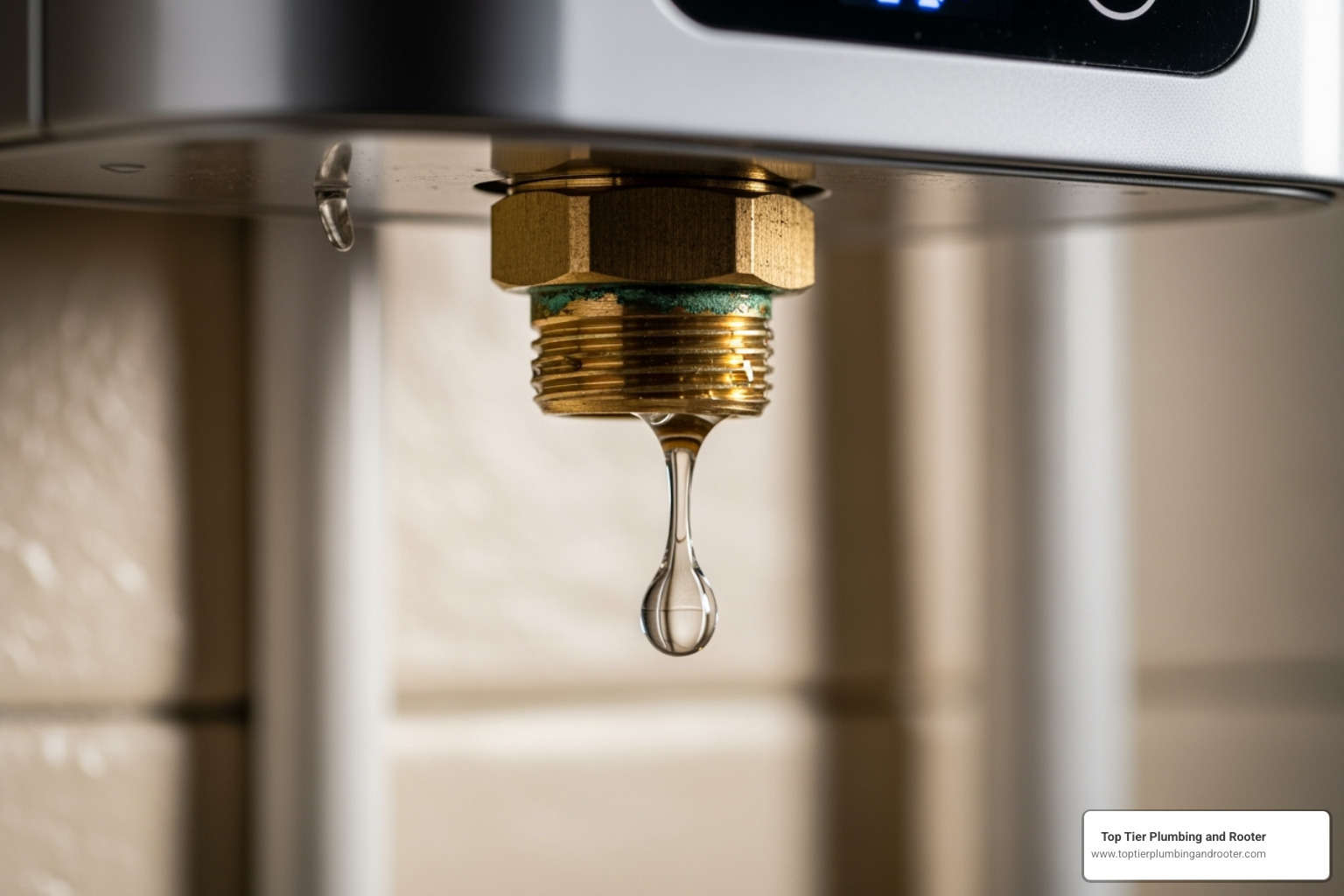
While you can tighten loose connections, any work involving internal components, gas lines, or electrical systems should be left to professionals.
When to Call a Professional for Tankless Water Heater Troubleshooting
While many tankless water heater troubleshooting steps are DIY-friendly, some problems require a professional. Knowing when to call an expert is crucial for safety and preventing more extensive damage.
Attempting repairs beyond your skill level can lead to bigger problems. Recognizing when to call a professional is the smart choice that often saves money and ensures the job is done correctly.
Signs You Need an Expert
Certain signs indicate it’s time to stop DIY troubleshooting and call for professional help.
The smell of gas is a critical warning sign. If you smell gas, evacuate your home immediately without using any electronics or light switches, and call your gas company from a safe location. Gas leaks are extremely dangerous.
Persistent error codes that don’t clear after a reset indicate a deeper problem. These often point to internal component failures that require professional diagnostic tools to identify and fix.
Major leaks, especially from inside the unit’s housing, suggest significant internal damage. Unlike a simple dripping connection, these require immediate professional attention to prevent water damage to your home.
If the unit shows no power after basic checks, there is likely a more complex electrical issue. This is especially dangerous with gas appliances and requires a professional.
If a repair requires disassembling the main unit, call a professional. Opening the main compartment can void your warranty and expose you to dangerous components.
Issues involving major components like the heat exchanger, main circuit board, or gas valve assembly are not DIY jobs. These repairs require specialized tools and expertise.
Attempting complex repairs can void warranties and create safety risks. A professional assessment might also reveal that replacement is a better option than repair, a topic we cover in Should You Replace or Repair Your Water Heater?.
The bottom line? When in doubt, call us out. Your safety and peace of mind are worth it.
Frequently Asked Questions about Tankless Water Heaters
After years of tankless water heater troubleshooting, we’ve compiled answers to the most frequently asked questions from homeowners in Riverside and San Bernardino counties.
How often should I flush my tankless water heater?
Flushing frequency depends on your water quality. Areas with hard water require more frequent maintenance.
We recommend annual flushing for most homes. However, if you have very hard water or notice signs of buildup like reduced flow or strange noises, flush it every six months. Regular maintenance is key to preventing larger issues.
The descaling process uses a solution like white vinegar to dissolve mineral deposits. Most manufacturer recommendations suggest this every 6-12 months, depending on water hardness.
For a complete walkthrough, check out our Tankless Water Heater Tune-Up Guide.
What is the ‘cold water sandwich’ effect?
The cold water sandwich is a common and often misunderstood quirk of tankless water heaters. It is a normal part of the unit’s operation, not a malfunction.
When you turn on the hot water, there is often cooled residual cold water sitting in the pipes from the last use. This ‘slug’ of cold water has to pass through the faucet before the newly heated water arrives.
This results in a brief cold spell between periods of hot water, especially if you turn the tap off and on again. While recirculation pumps can minimize this effect, they are not necessary for most households.
Why does my unit shut off in the middle of a shower?
An unexpected shutdown during a shower is usually the unit protecting itself or signaling a problem.
The most common culprit is the flow rate dropping below the minimum flow rate requirement (typically 0.4-0.6 GPM). Low water pressure or a water-saving showerhead can cause this.
System overload is another cause. If multiple hot water appliances are running, the demand may exceed the unit’s capacity, causing a temporary shutdown.
A more serious cause is a safety sensor trip. The unit will shut down if it detects a dangerous condition like a blocked exhaust vent or overheating. These safety shutdowns should not be ignored.
Finally, the unit might shut off if it reaches its temperature limit, often due to mineral buildup. This highlights the importance of regular maintenance and tankless water heater troubleshooting.
Get Your Hot Water Flowing Again
A cold shower is a frustrating start to the day. This comprehensive tankless water heater troubleshooting guide has covered the most common problems and provided practical solutions to restore your hot water.
Many issues have simple fixes. Checking the power supply, cleaning a clogged inlet filter, or looking up an error code can often solve the problem without professional help.
Regular maintenance is your secret weapon against most tankless water heater headaches. Flushing your unit annually (or more often in hard water areas) prevents the mineral buildup that leads to many common issues.
However, safety always comes first. If you smell gas, find a major leak, or face a problem beyond basic troubleshooting, call a professional. Some repairs require specialized tools and expertise.
At Top Tier Plumbing and Rooter, we know water heater problems are urgent. We offer 24/7 service to homeowners throughout Riverside and San Bernardino counties. Our experienced team provides upfront pricing and a commitment to quality work done right the first time.
Don’t let a faulty water heater disrupt your comfort. Whether it’s a simple fix or a complex repair, for expert tankless water heater repair and service, contact us today! We’ll restore the reliable hot water you depend on.


